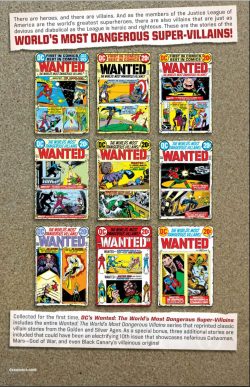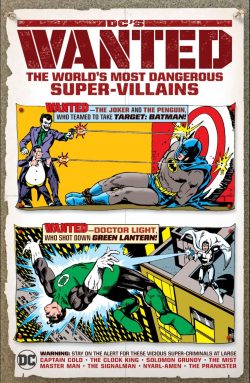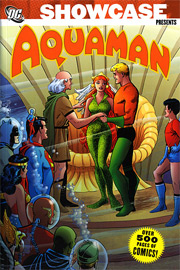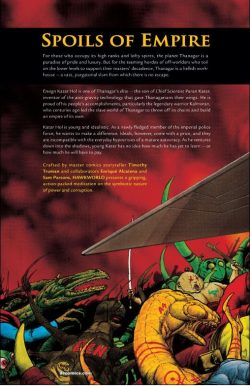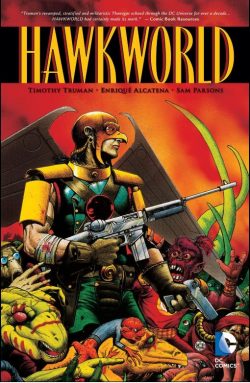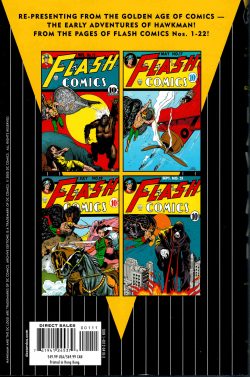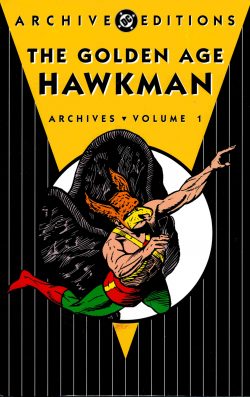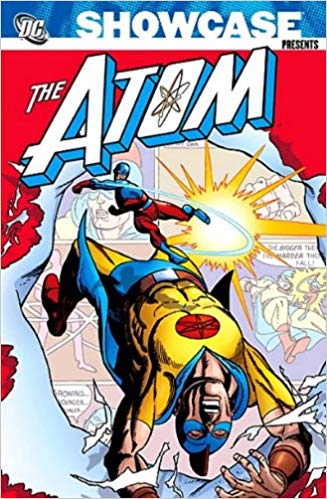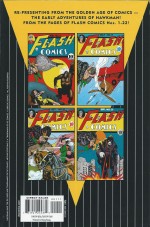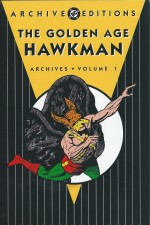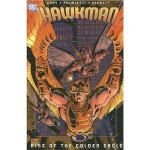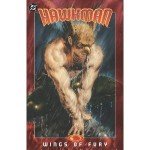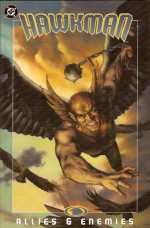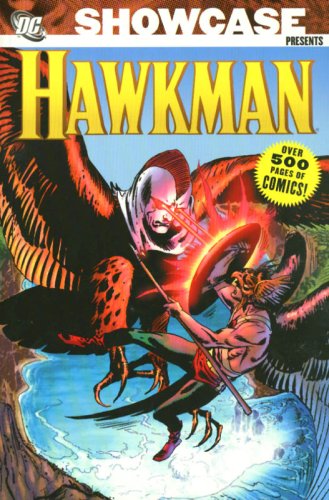
By Gardner F. Fox, Bob Haney, Joe Kubert, Gil Kane, Murphy Anderson, Howard Purcell, Carmine Infantino & various (DC Comics)
ISBN: 978-1-4012-1280-3 (TPB)
Not all passions are romantic: mine is to finally have all old comics forever available in curated editions. These astoundingly engaging Silver Age tales are another treat inexplicably unavailable in modern, full-colour editions, either physically or digitally.
On a timely note, however, this book does highlight one of the most effective and enduring romantic crime-busting, world-saving partnerships in comics…
With the superhero revival in full swing by 1961, Editorial genius Julius Schwartz turned to resurrecting one of DC’s most visually arresting and iconic Golden Age characters. Once again eschewing mysticism for science fiction (the original Hawkman was a reincarnated Egyptian prince murdered by a villainous priest), Schwartz picked scripter Gardner F. Fox – who created the Golden Age great – and artist Joe Kubert to construct a new hero for the Space Age.
This titanic tome is still readily available from online retailers and packs a big punch, gathering the works of the Winged Wonders from The Brave and the Bold #34-36, #42-44 and #51; The Atom #7; Mystery in Space #87-90 and Hawkman #1-11: cumulatively spanning February/March 1961 to December 1965/January 1966.
Katar Hol and his wife Shayera Thal are police officers on their own planet of Thanagar. They’ve travelled to Earth from the star system Polaris in pursuit of a spree-thief named Byth who assaulted a scientist and stole a drug bestowing the ability to change into anything. Thus the scene was set in ‘Creature of a Thousand Shapes’ which graced The Brave and the Bold #34 (cover-dated February/March 1961): a spectacular work of graphic magic, with the otherworldly nature of the premise rendered captivatingly human by the passionate, moody expressiveness of Kubert’s art. It is a minor masterpiece of comic storytelling, and still a darned good read.
The high-flying heroes returned in the next issue, now stationed on Earth to study Terran police methods. In ‘Menace of the Matter Master’ they defeat a plundering scientist who has discovered a means to control elements, before ‘Valley of Vanishing Men’ takes the strange visitors from another world to the Himalayas to discover the astounding and ironic secret of the Abominable Snowmen.
Last chance in the try-out session, B&B #36 then sees them defeat a modern day wizard in ‘Strange Spells of the Sorcerer’ and after, save Earth from another Ice Age whilst defeating ‘The Shadow Thief of Midway City’.
With the three-issue audition over, the publishers sat back and waited for the fan letters and sales figures… and something odd happened: fans were vocal and enthusiastic, but the huge sales figures just weren’t there. It was inexplicable. The quality of the work was plain to see on every page, but somehow not enough people had plunked down their dimes to justify an ongoing Hawkman series
A year later DC tried again. The Brave and the Bold #42 (June/July 1962) featured ‘The Menace of the Dragonfly Raiders’ and found Katar and Shayera returning to Thanagar just in time to encounter a bizarre band of alien thieves. Here was superhero action in a fabulous alien locale and the next issue maintained the exoticism – at least initially – before Hawkman and Hawkgirl returned to Midway City to defeat a threat to both worlds – ‘The Masked Marauders of Earth’.
One last B&B issue followed – #44, October-November 1962 – with two splendid short tales. ‘Earth’s Impossible Day’focused on Shayera’s desire to celebrate a holiday tradition of Thanagar whilst eerie doomsday thriller ‘The Men who Moved the World’ explored lost civilisations and the return of Earth’s original owners… and then the Hawks vanished again. It certainly looked like this time the magic had faltered.
That, however, was not the end of the saga. Convinced he was right, Schwartz retrenched. Enjoying some success with the new Atom title and mindful of the response when he had teamed the Flash and Green Lantern in the summer of 1962, the editor had writer Fox include the Winged Wonder in ‘The Case of the Cosmic Camera’ (The Atom #7, June/July 1963): an interplanetary thriller illustrated by Gil Kane and Murphy Anderson. This invasion rollercoaster ranged from the depths of space to Earth’s most distant past.
This new clean-limbed version clearly found fan-favour and in 1963 Hawkman returned! Again!
Mystery in Space had been the home of Adam Strange since issue #53 and with #87 (November 1963) Schwartz moved the Winged Wonders into a back-up slot; even granting them occasional cover-privileges. Still written by Fox, Kubert’s moody art had been superseded by the clean, graceful illustration of Anderson. ‘The Amazing Thefts of the I.Q. Gang!’ was followed a month later by ‘Topsy-Turvy Day in Midway City!’
With the management now on board, guest appearances to maximise profile were easier to find. Hawkman briefly returned to The Brave and the Bold with #51 (December 1963/ January 1964) to team with Aquaman and face the ‘Fury of the Exiled Creature!’
This quirky tale of monsters, magic and mayhem in sunken Atlantis was written by Bob Haney and illustrated by the criminally neglected Howard Purcell, and then it was back to Mystery in Space #89 and the ‘Super-Motorized Menace!’the month after that.
These were brief, engaging action pieces, before issue #90 offered a full length story teaming the Hawks and Adam Strange in a legendary End-of the-World(s) epic. ‘Planets in Peril!’ – illustrated by Carmine Infantino & Murphy Anderson – was the last Hawkman back-up. From the next month, and after three years of trying, Hawkman would soar in his own title.
Cover-dated April/May 1964, Hawkman #1 is a gem of an issue by Fox & Anderson. Two of the most visually arresting characters in comics, the Hawks had one of the most subtle and sophisticated relationships in the business. Like Sue and Ralph Dibney (Elongated Man and wife) Katar and Shayera are equal partners, and both couples were influenced by the Nick and Nora Charles characters of the Thin Man movies. Like those progenitors, the interplay of the Hols at home or at work is always rich in humour and warmth.
In ‘Rivalry of the Winged Wonders’, and whilst accommodatingly recapping their origins for newcomers, the couple decide to turn their latest case into a contest. Hawkgirl (eventually and more appropriately Hawkwoman) would use Thanagarian super-science to track and catch a band of thieves whilst Hawkman limited himself to Earth techniques and tools in solving the crime.
This charmingly witty yarn is balanced by action thriller ‘Master of the Sky Weapons’ as ancient Mayan warrior Chacthreatens the world with unearthed alien super weapons whilst the second issue featured the ‘Secret of the Sizzling Sparklers!’ – an action-packed thriller concerning trans-dimensional invaders – and closed with ‘Wings across Time’: a mystery revolving around the discovery of the flying harness of the legendary Icarus.
Another brain-teaser opened the third issue. Scientific bandits proved less of a menace than ‘The Fear that Haunted Hawkman’ whilst ordinary thugs and an extraordinary alien owl converged to make our heroes ‘Birds in a Gilded Cage’.
Issue #4 opened with a tale that would revolutionise DC comics. ‘The Girl who Split in Two!’ introduced Zatanna, daughter of a magician who had fought crime in the 1940s only to “mysteriously disappearâ€.
From the very first issue, and for over a decade, Zatarra was a hero in the Mandrake mould who fought evil in the pages of Action Comics. During the Silver Age, Gardner Fox had Zatarra’s young and equally gifted daughter search for the missing mage by teaming up with a selection of superheroes he was currently scripting (if you’re counting, these tales appeared in Hawkman #4, The Atom #19, Green Lantern #42, and in the Elongated Man back-up strip in Detective Comics #355. A very slick piece of backwriting latterly included the high-profile Caped Crusader via Detective #336 – ‘Batman’s Bewitched Nightmare’.
The saga concluded in Justice League of America #51 and ‘Z – As in Zatanna – and Zero Hour!’)…
This wide, long-running experiment in continuity proved that there was a dedicated fan-base out there with a voracious appetite for experimentation and relatively deep pockets. Most importantly, it finally signalled the end of the period where DC heroes largely lived and battled in self-imposed worlds of their own.
Back-up ‘The Machine that Magnetized Men!’ is another fine tale, as the Pinioned Paladins use reason and deduction to defeat thieves who are impossible to touch.
‘Steal, Shadow – Steal!’ in number #5 is the first full-length thriller, as the ruthless Shadow Thief returns seeking revenge, and believing that causing the next Ice Age is an acceptable consequence of his schemes. Issue #6 is another epic, and one that turned DC’s peculiar obsession with gorillas into a classic adventure.
‘World Where Evolution Ran Wild!’ draws our heroes to fabled Illoral, where a scientist’s explorations and interventions have stretched Natural Selection to un-natural limits. Bold, brash and daft in equal proportions, this is a fabulous romp and seeing again the cover where Hawkman struggles for his life against a winged gorilla makes the adult me realise those DC chaps might have known what they were doing with all those anthropoid covers!
By issue #7 (April-May 1965) the world was gripped in secret agent fever as the likes of James Bond, the Man from U.N.C.L.E., and a host of others sashayed across our TV screens. Comics were not immune, though spies had been a staple threat there for decades. Before Hawkman joined the gang however, he had to deal with the rather mediocre threat posed by ‘The Amazing Return of the I.Q. Gang!’
They were quickly returned to prison and the Hawks moved on to face the ‘Attack of the Crocodile-Men!’: a high-octane super-science thriller that introduced C.A.W. – the Criminal Alliance of the World…
Another supremely captivating cover adorned #8, as the Hawks fought an ancient Roman artificial intelligence built by the not-so mythical Vulcan himself in ‘Giant in the Golden Mask!’, before defeating an alien Harpy who’d been buried for half a million years in ‘Battle of the Bird-Man Bandits’.
Hawkman #9 saw The Atom as guest star when an old villain returned with a seemingly perfect revenge plan for full-length super-thriller ‘Master Trap of the Matter Master!’, after which #10 saw a playful Fox at his best in both ‘Hawkman Clips the Claws of C.A.W!’ – another espionage drama with a delicious subplot as the Winged Wonder aids a sexy CIA agent with a big secret of her own, before solving ‘The Magic Mirror Mystery’: a fair-play tale brainteaser with lots of high-flying action to balance the smart stuff.
This glorious first volume closes with another superb full-length epic as ‘The Shrike Strikes at Midnight!’ and our heroes trail a super-powered, winged bandit all over the world and on to the star system Mizar, in a gripping tale of crime, super-villainy, aliens, revolutions and even dinosaurs.
Hawkman grew to be one of the most iconic characters of the second superhero boom, not just for the superb art but also because of a brilliant, subtle writer with a huge imagination. These tales are comfortably familiar but somehow grippingly timeless. Yet comics are a funny business; circumstances, tastes and fashions often mean that wonderful works are missed and unappreciated. Don’t make the same mistake readers did in the 1960s. Whatever your age, read these astounding adventures and become a fan. It’s never too late.
© 1961-1966, 2007 DC Comics. All Rights Reserved.

